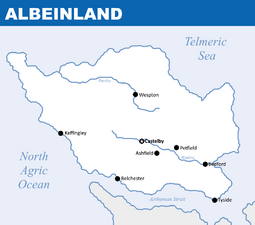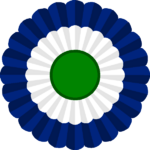Albeinland: Difference between revisions
Jump to navigation
Jump to search
The ©rusader (talk | contribs) mNo edit summary |
No edit summary |
||
| Line 2: | Line 2: | ||
{{WIP}} | {{WIP}} | ||
{{Infobox country | {{Infobox country | ||
|conventional_long_name | |conventional_long_name = Commonwealth of Albeinland | ||
|common_name | |common_name = Albeinland | ||
|image_flag | |image_flag = [[File:Flag of Albeinland.png|141px]] | ||
|alt_flag | |alt_flag = Flag of Albeinland | ||
|image_coat | |image_coat = [[File:Albeinland_coa.png|94px]] | ||
|alt_coat | |alt_coat = Cockade of Albeinland | ||
|national_motto | |symbol_type = Cockade | ||
|national_anthem | |national_motto = ''Domine, dirige nos'' ({{wp|Latin language|Cambran}}) <br><small>"O Lord, direct us"</small> | ||
|image_map | |national_anthem = {{wp|''Battle Hymn of the Republic''}} | ||
|alt_map | [[File:MediaPlayer.png|https://www.youtube.com/watch?v=Jy6AOGRsR80|210px]] | ||
|map_caption | |image_map = | ||
|image_map2 | |alt_map = | ||
|alt_map2 | |map_caption = | ||
|map_caption2 | |image_map2 = [[File:Alb_map_1.png|255px]] | ||
|capital | |alt_map2 = Political map of Albeinland | ||
|largest_city | |map_caption2 = Political map of Albeinland | ||
|official_languages | |capital= {{flagicon image|Flag_of_Austria.svg}} [[Castelby]] | ||
|largest_city= capital | |||
|official_languages = {{wp|English language|Albish}} | |||
|national_languages = <!--Country/territory-wide languages recognised but not necessarily in country/territory-wide law, etc--> | |national_languages = <!--Country/territory-wide languages recognised but not necessarily in country/territory-wide law, etc--> | ||
|regional_languages = <!--Languages recognised or associated with particular regions within the country/territory--> | |regional_languages = <!--Languages recognised or associated with particular regions within the country/territory--> | ||
|ethnic_groups | |ethnic_groups = [[Albeinland#Demographics|See demographics]] | ||
|ethnic_groups_year | |ethnic_groups_year = 2020 | ||
|demonym | |demonym = Albish | ||
|government_type | |government_type = {{wp|Unitary state|Unitary}} {{wp|Parliamentary system|parliamentary}} {{wp|republic}} | ||
{{wp| | |leader_title1 = [[Lord Protector of Albeinland|Lord Protector]] | ||
|leader_title1 | |leader_name1 = [[George Owen]] | ||
|leader_name1 | |leader_title2 = [[Prime Minister of Albeinland|Prime Minister]] | ||
|leader_title2 | |leader_name2 = [[Vincent Lloyd]] | ||
|leader_name2 | |legislature = [[General Assembly of Albeinland|General Assembly]] | ||
|legislature = [[ | |upper_house = [[State Council of Albeinland|State Council]] | ||
| | |lower_house = [[House of Commons of Albeinland|House of Commons]] | ||
| | |sovereignty_type = Establishment | ||
|established_event1 = [[ | |established_event1 = [[Unification of Albeinland|Unification]] | ||
|established_date1 = 08 December 1012 | |established_date1 = 08 December 1012 | ||
|established_event2 = [[ | |established_event2 = [[Magnanimous Revolution|Republic]] | ||
|established_date2 = | |established_date2 = 10 May 1583 | ||
| | |established_event3 = [[Common Charter of Albeinland|Constitution]] | ||
| | |established_date3 = 13 November 1786 | ||
|area | |area= | ||
|area_km2 | |area_km2= | ||
|area_sq_mi | |area_sq_mi= | ||
|population_census = {{Increase}} 6,472,318 | |||
|population_census_year = 2020 | |||
|population_census | |population_density_km2 = | ||
|population_census_year | |population_density_sq_mi = | ||
|population_density_km2 | |GDP_nominal = {{Increase}} £270,309,888,952 | ||
|population_density_sq_mi | |GDP_nominal_year = 2020 | ||
|GDP_nominal | |GDP_nominal_per_capita = {{Increase}} £41,764 | ||
|GDP_nominal_year | |||
|GDP_nominal_per_capita | |||
|Gini = 17.3 | |Gini = 17.3 | ||
|Gini_year = 2020 | |Gini_year = 2020 | ||
|Gini_change = | |Gini_change = decrease | ||
|HDI = 0. | |HDI = 0.924 | ||
|HDI_year = 2020 | |HDI_year = 2020 | ||
|HDI_change = increase | |HDI_change = increase | ||
|currency | |currency = [[Albish Sterling|Sterling]] (ALB, £) | ||
|time_zone | |time_zone = [[Castelby Central Time]] | ||
|utc_offset | |utc_offset = +1 | ||
|cctld = .ab | |||
|calling_code = +32 | |||
|cctld | |||
|calling_code | |||
}} | }} | ||
cool nation in aurorum. | |||
==Etymology== | ==Etymology== | ||
==History== | ==History== | ||
==Geography== | ==Geography== | ||
===Climate=== | ===Climate=== | ||
===Environment=== | ===Environment=== | ||
==Politics== | |||
===Government=== | |||
===Administrative divisions=== | |||
===Law=== | |||
=== | |||
===Foreign relations=== | ===Foreign relations=== | ||
===Military=== | |||
==Economy== | ==Economy== | ||
===Energy=== | ===Energy=== | ||
=== | ===Infrastructure=== | ||
===Tourism=== | ===Tourism=== | ||
==Demographics== | ==Demographics== | ||
===Population=== | |||
===Ethnic groups=== | |||
===Religion=== | |||
===Healthcare=== | ===Healthcare=== | ||
===Education | ===Education=== | ||
=== | ====Science==== | ||
===Urbanization=== | |||
==Culture== | ==Culture== | ||
===Music and | ===Architecture=== | ||
===Music=== | |||
===Literature=== | |||
===Cuisine=== | |||
===Cinema and theatre=== | |||
===Media=== | ===Media=== | ||
=== | ===Visual arts=== | ||
===Sports=== | ===Sports=== | ||
===Holidays=== | ===Holidays=== | ||
==See also== | ==See also== | ||
{{Albeinland topics}} | {{Albeinland topics}} | ||
[[Category:Albeinland]] | |||
[[Category: | [[Category:Countries of Aurorum]] | ||
Revision as of 22:48, 20 August 2020
This article is incomplete because it is pending further input from participants, or it is a work-in-progress by one author. Please comment on this article's talk page to share your input, comments and questions. Note: To contribute to this article, you may need to seek help from the author(s) of this page. |
Commonwealth of Albeinland | |
|---|---|
| Motto: Domine, dirige nos (Cambran) "O Lord, direct us" | |
| Anthem: Battle Hymn of the Republic
| |
 Political map of Albeinland | |
| Capital and largest city | |
| Official languages | Albish |
| Ethnic groups (2020) | See demographics |
| Demonym(s) | Albish |
| Government | Unitary parliamentary republic |
| George Owen | |
| Vincent Lloyd | |
| Legislature | General Assembly |
| State Council | |
| House of Commons | |
| Establishment | |
| 08 December 1012 | |
• Republic | 10 May 1583 |
| 13 November 1786 | |
| Population | |
• 2020 census | |
| GDP (nominal) | 2020 estimate |
• Total | |
• Per capita | |
| Gini (2020) | low |
| HDI (2020) | very high |
| Currency | Sterling (ALB, £) |
| Time zone | UTC+1 (Castelby Central Time) |
| Calling code | +32 |
| Internet TLD | .ab |
cool nation in aurorum.


